Activity Archive
October 2025
Little Moos - 0 to 2 years




Resources Needed
The tray was filled with flour to represent a baking workspace and included mixing bowls, spoons, measuring cups, bun cases, a muffin tin, and pretend ingredients such as eggs with shaving foam and a ball.
Description
The children became deeply involved in imaginative and role play, taking on the roles of bakers and chefs. They worked collaboratively to fill cupcake cases, stir mixtures, and share utensils. Many children engaged in conversations about what they were “baking,” using descriptive language and recalling real-life experiences from home. The sensory element of the flour encouraged them to explore texture by running it through their fingers, drawing shapes, and making marks in the flour.
Benefits
This activity supported multiple areas of learning within the EYFS framework. Communication and language skills were promoted as children used and extended their vocabulary related to cooking and baking. They listened to one another’s ideas, followed instructions, and engaged in meaningful conversations. The activity also supported mathematical development through measuring, counting, and comparing quantities while filling containers and cupcake cases.
Physical development was encouraged as children used fine motor control to scoop, pour, and mix materials, strengthening their hand muscles and coordination. The experience also supported personal, social, and emotional development, as children shared resources, took turns, and worked cooperatively. Additionally, expressive arts and design was fostered through imaginative role play, allowing children to express creativity and recreate familiar experiences. Overall, this engaging sensory play provided rich opportunities for learning through exploration, imagination, and social interaction.

Daisy Buds - 2 to 3 years



Resources Needed
The tray featured toy diggers, tractors, trucks, and road tracks, alongside natural and textured materials such as pasta, cornflakes, sand, pinecones, and wooden logs.
Description
The children were highly engaged in role play, taking on the roles of builders, drivers, and farmers. They communicated with one another to plan what their vehicles were doing and discussed where to place items, showing developing social and language skills. The variety of materials encouraged them to explore different textures and experiment with how the vehicles interacted with them—for example, pushing through pasta, scooping cornflakes, or driving over sandy “roads.”
Benefits
-
This activity supported several areas of learning within the EYFS framework. It promoted communication and language development as children described their actions, shared ideas, and used vocabulary related to construction, transport, and materials. Physical development was enhanced through fine motor control while handling vehicles and manipulating loose parts. Understanding the world was fostered as children explored concepts related to building, farming, and the use of machinery.
-
The tray also encouraged personal, social, and emotional development, as children played cooperatively, took turns, and negotiated roles. The open-ended nature of the materials inspired creative and imaginative play, allowing children to develop their storytelling skills and problem-solving abilities. Overall, this engaging and hands-on activity provided rich opportunities for exploration, collaboration, and learning through play.

Meadow Explorers - 3 to 5 years


Resources Needed
The tray included coloured rice, small kitchen utensils, toy insects, and character cutouts from the book such as the witch, cat, frog, dog, and dragon.
Description
The children were highly engaged in imaginative and small-world play, using the story as inspiration to explore different roles and ideas. They shared ideas with their peers, took turns using the tools, and talked about what was happening in their play. Some children recalled key phrases from the book, while others added their own dialogue, showing confidence and creativity in storytelling.
Benefits
This activity supported several areas of learning within the EYFS framework. It promoted communication and language development as children discussed the story, described their actions, and used new vocabulary such as “cauldron,” “broomstick,” and “spell.” Literacy skills were strengthened through story recall, sequencing, and engagement with the book’s rhymes and rhythm. Through handling the utensils and small objects, children developed their fine motor skills, improving coordination and control.
The sensory elements encouraged exploration and curiosity, helping children to understand textures, colours, and cause and effect through pouring and mixing. Socially, the tray fostered personal, social, and emotional development, as children collaborated, shared resources, and respected one another’s ideas. Overall, this engaging, hands-on experience encouraged creativity, storytelling, and language development while deepening the children’s connection to the story.


